7ª edición: Del 4 al 13 de diciembre 2015 | English

![]() JAPAN MEDIA ARTS
JAPAN MEDIA ARTS
![]() FESTIVAL
FESTIVAL
![]()
![]() ARS ELECTRONICA
ARS ELECTRONICA
![]()
![]() ART FUTURA
ART FUTURA
![]()
![]() MUNDOS DIGITALES
MUNDOS DIGITALES
![]()
![]() NOW & AFTER. Moscú
NOW & AFTER. Moscú
![]()
![]() Media DOME
Media DOME
![]()
![]() FEMLINK
FEMLINK
![]()
![]() GAME On! Videojuegos
GAME On! Videojuegos
![]()
![]() EL MUR. Berlín
EL MUR. Berlín
![]()
![]() CINEWEST. Sidney
CINEWEST. Sidney
![]()
![]() FIA. Uruguay
FIA. Uruguay
![]()
![]() DIGITAL LANDSCAPE
DIGITAL LANDSCAPE
![]() & Programa Curators
& Programa Curators
![]() - HELSINKI
- HELSINKI
![]()
![]() - ARGENTINA
- ARGENTINA
![]()
![]() MADE IN CANARIAS
MADE IN CANARIAS
![]()
![]() IMAGEN DIGITAL
IMAGEN DIGITAL
![]() Videoarte
Videoarte
![]() Videodanza
Videodanza
![]() Cortometraje/Film/3D
Cortometraje/Film/3D
![]() Web Film
Web Film
![]() Animación
Animación
![]()
![]() Arte Ciencia Innovación
Arte Ciencia Innovación
![]() Artificial life
Artificial life
![]() Software art
Software art
![]() Trangenic art
Trangenic art
![]() Generative art
Generative art
![]() Bioart
Bioart
![]() Nanotecnología
Nanotecnología
![]() Geospatial storytelling
Geospatial storytelling
![]() Videojuegos
Videojuegos
![]() Robótica
Robótica
![]() Free Software
Free Software
![]() 2D & 3D Animación
2D & 3D Animación
![]() Net-art
Net-art
![]() Comunidades Digitales
Comunidades Digitales
![]() Redes Sociales
Redes Sociales
![]() Blog, videoblog
Blog, videoblog
![]() Desarrollo Apps
Desarrollo Apps
![]() Plataformas móviles
Plataformas móviles
![]() Visualización datos
Visualización datos
![]() Mapping
Mapping
![]() Acciones telepresencia
Acciones telepresencia
![]()
![]() somos
somos
![]()
![]() programa 2015
programa 2015 ![]()
![]() patrocinadores &
patrocinadores &
![]() colaboradores
colaboradores
![]()
![]() fotos de la sede
fotos de la sede ![]()
![]() lugar
lugar
![]()
![]()
![]() evento 2009
evento 2009
![]()
![]() evento 2010
evento 2010
![]()
![]() evento 2011
evento 2011
![]()
![]() evento 2012
evento 2012
![]()
![]() evento 2013
evento 2013
![]()
![]() evento 2014
evento 2014
![]()
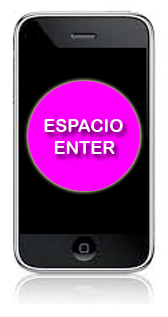
- Artificial Life
- Software art
- Transgenic art
- Generative art
- Bioart
- Nanotecnología
- Geospatial storytelling
- Videojuegos
- Robótica
- Free Software
- 2D & 3D Animación
- Net-art
- Comunidades Digitales
- Redes sociales
- Blog, videoblog
- Desarrollo Apps
- Creación plataformas móviles
- Data Visualization
- Mapping
- Telesharing actions
- Telepresencia
![]()
Convocatoria Internacional 2015
![]()
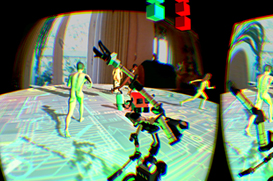
Alena Mesarosova, Manuel Ferrer
Valencia. España
http://manusamoandbzika.webs.com/
Proyecto: Robot & Robotnik
In “Robot & Robotnik” artgame we employ the combination of technologies AR and EEG for the users immersion and interaction. AR helps to invoke the brain processes capable of binding the real and virtual dimensions, influencing the perception of space where our own mind locates us. EEG establishes a communication channel of the double sense between the artwork and the viewer. The user has the influence on the course of the game, while the actions within the game causes the changes of the user's mental state.
The the interactive element of the game is elicited by the EEG data, so we define it as a “Neuro-ARt-Game”. The game features the robot characters and humans’ characters - “Robotnik”, which means “worker”. The human characters have a different morphology which represent a whole humanity. The robots are designed as a cold metallic entities which possess a primitive artificial intelligence. They share the same virtual space on a round scenario, simulating a circular theater, where the user can move freely and observe the installation from 360 degrees. The characters play their role depending on the mental state of user, which has the power to maintain the state of peace or war between the humans and robots. The state of meditation grants the peaceful behavior and the high attention level in addition to the lack of meditation induce the characters to persecute each other.
tag: videogames
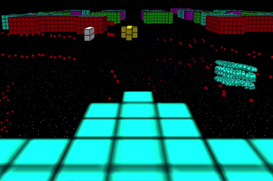
Santa Cruz de Tenerife. España
http://voxelinvaders.tumblr.com/
https://vimeo.com/danielblanco3d
Proyecto: Voxel Invaders Reload el Videojuego
Voxel Invaders Reload es un videojuego que recrea el clásico space invaders con tecnología actual 3D, Realidad Aumentada y Realidad Virtual. Con un motor propio el juego puede adaptarse según la ocasión:
1) versión para jugar en un mueble arcade presentada en Oxygen Weekend
2) versión mapping jugable presentada en fi2
3) versión multiplayer presentada en TLP2015
4) versión con Realidad Aumentada presentada en TLP2015
5) versión con Realidad Virtual presenada en TLP2015 en un headset Lakento
6) versión webGL (HTML5) experimental jugable desde el navegador web de escritorio
https://vimeo.com/134559554
https://vimeo.com/119343196
https://vimeo.com/117849191
http://dbr3d.blogspot.com.es/2015/05/voxel-invaders-reload-webgl.html
Desarrollado con Unity, Vuforia SDK, Open Dive SDK y 3dsmax.
tag: videogames
![]()
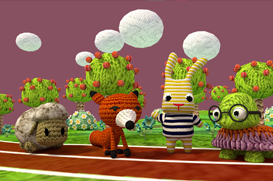
Manusamo & Bzika
Alena Mesarosova, Manuel Ferrer
Valencia. España
http://manusamoandbzika.webs.com/
Proyecto: Rabbit Mind Runner
Un proyecto que explora las posibilidades del Neuro-Art-Game. Proponemos la introducción de electroencefalogramas como sustitución de los controles habituales que encontramos en los videojuegos tradicionales, dejando de lado el Joystick para primar la interacción neuronal entre obra y usuario.
El juego propone una serie de carreras mentales, donde el usuario adopta el avatar de un personaje representado por un conejo virtual, introduciendo al usuario en el mundo animal, donde sus adversarios son animales, los cuales aumentan o disminuyen la dificultad del juego en función de las actividades motoras y/o mentales de dichos animales.
El usuario es capaz interactuar con su avatar mediante la captación de su actividad cerebral mediante un electroencefalograma (EEG) no invasivo. Este EEG nos permite conocer el grado de concentración y meditación en que se encuentran los usuarios. Relacionando el grado de concentración con la velocidad a la que se desplaza el avatar dentro del espacio virtual, a mayor concentración mayor velocidad. También hemos considerado necesario incrementar la dificultad al avanzar dentro de los niveles que posee el juego; para ello el avatar adversario del ultimo nivel se desplaza a una velocidad superior al avatar de usuario, de manera que sólo con los niveles de concentración sea prácticamente imposible de ganar en el juego, pues en este último nivel hemos introducido la utilización de valores del EEG relacionados con la meditación del usuario, generando que sí la meditación del usuario supera unos valores el adversario virtual se detenga y entre en fase de reposo.
Como la mayoría de usuarios no están familiarizados con la utilización de EEG hemos introducido dentro del juego una pruebas o acertijos mentales que incitan al usuario a aumentar su grado de concentración para poder resolverlos, pudiendo mejorar el control de las actividades cerebrales dentro del juego, ganando experiencia en la utilización de estos dispositivos, haciendo posible que el usuario obtenga mejores resultados en el juego tras jugar varias partidas u horas, como sucede en los videojuegos tradicionales
tag: videogames
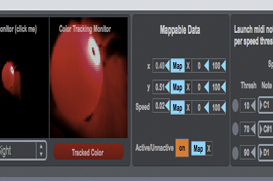
Gustavo Silveira
Pelotas. Brasil
http://www.gustavosilveira.net/#!-----/c6qh
https://www.youtube.com/channel/UC3AeUNOpzuRVBqXpoIh2XTA/videos
Proyecto: ( . . . ) A juggling/motion tracking suite for "Max for Live"
Was born from my desire of doing juggling and music at the same time, of putting the juggler in control of the music, of using the juggler's abilty of manipulating several objects at time into the electronic music performance.
( . . . ) is a group of free Ableton Live Max For Live devices dedicated to map juggling into music. Although it's dedicated to juggling, it can be used to map any object's movement into music, since it's based in a motion tracking system.
Here, you can download the software, the documentation, and the paper that I wrote about it "Using juggling as a controller for computer-generated music - an overview of the creation of an interactive system between juggling and electronic music"
tag: open source
![]()
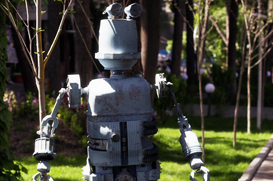
Behrouz Bagheri
Teherán. Irán
www.behrouzbagheri.com
https://vimeo.com/behrouzbagheri
https://www.youtube.com/user/behrouzvfx
Proyecto: The Hard Dream
Visual Effect Supervisor
tag: robotic
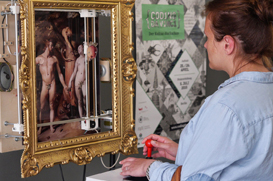
Berlín. Alemania
http://katihyyppa.com
https://vimeo.com/128072915
Proyecto: Forbidden Fruit Machine
The "Forbidden Fruit Machine" is an interactive installation, which is based on a painting called “The Fall of Man” created by Cornelis Cornelisz. van Haarlem in 1592. The painting, which resides at the Rijksmuseum in Amsterdam, depicts Eve and Adam in the Garden of Eden, being tempted by the serpent to eat the forbidden fruit. When Cornelis made his masterpiece, oil paintings were the hi-tech medium of the time. They featured incredible detail and ultra high resolution. Some 400 years later we turned Cornelis’ artwork into today’s equivalent top-notch medium, namely, a video game, where the spectator - or player - can explore the painting using a joystick. However, instead of an LCD display, the installation works with mechanical parts, which are driven by an Arduino microcontroller.
The central character of the game is the forbidden fruit. The player can take over the destiny of the apple by moving it around with a plotter-like mechanism in order to discover special effects hidden in the picture. Subtle lights give a hint where the effects can be found and a joystick button press triggers them. For example, pressing the button over the cat in Eve’s and Adam’s feet elicits a heart-breaking meow, while letting Eve to eat the apple results in an even more dramatic effect including a thunder storm!
In addition to connecting the art mediums of the past and the present, the installation is inspired by open cultural content, that is, digital images and sounds which are in the public domain or licensed with an open license. The image of “The Fall of Man” is from the Rijksmuseum’s public domain collection and the sounds used in the installation are from the Internet Archive, the Free Music Archive and Freesound. We have also shared the documentation of the installation including the 3D printing files and the Arduino sketches under an open license in the spirit of open culture.
tag: robotic
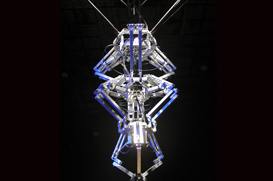
Pablo Ventura
Zurich. Suiza
www.ventura-dance.com
https://www.youtube.com/watch?v=xBki9nYeZ9Q
https://www.youtube.com/watch?v=xzv_LOdHqMk
Proyecto: Kubic's Cube
“Kubic” is a two and a half meter long aluminium robot that hangs from a ceiling, and moves according to the construction of its limbs as it performs to the music and sounds of Francisco López.
“Kubic’s Cube” is a performative Installation with “Kubic” acting as a dance-machine, a cubist kinetic sculpture and an instrument of rhythmic movement. The Installation (3-4 hours) :“Kubic” hangs in a dark space surrounded by sounds of a jungle. The public moves freely in space and regards the robot from different perspectives. A motion tracking software registers the whereabouts of the public and triggers the robot to react to the approach and nearness of the spectators. An ambivalence takes place between the sounds of organic life in a jungle and a machine, and the public’s perception of “Kubic” fluctuates between a kinetic sculpture and a living organism.
tag: robotic
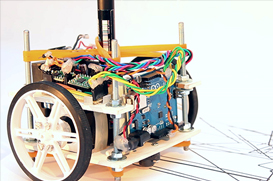
Madrid. España
www.sadabatouron.com
https://vimeo.com/121399478
Proyecto: S1T Aleagrafías
En 1769, Wolfgang von Kempelen fabricó El Turco; una magnífica simulación de un autómata cuya función era jugar y en la mayoría de los casos, ganar al ajedrez, contra un adversario humano. Y decimos una simulación, porque realmente tras la puesta en escena se hallaba un gran secreto; un ser humano escondido a la mirada del público era quien realmente jugaba.
Lo que Kempelen mostró y demostró en aquel momento, es algo que todavía a día de hoy con nuestra innovación tecnológica se evidencia; y es que un autómata sólo puede estar capacitado para simular lo propiamente humano. Éste, cuyo funcionamiento está basado en fórmulas matemáticas, ecuaciones y cálculos complejos, no puede aspirar a reproducir la esencia humana, teniendo en cuenta que cada individuo y sus acciones, pensamientos, actitudes y maneras de hacer son particulares, y donde entran en juego aquellas experiencias que dan lugar a diferentes maneras de estar y ser en el mundo. Un robot o un autómata, cuya naturaleza está basada en un razonamiento únicamente lógico; no puede ejecutar aquello que no le es propio.
De ahí, nuestro empeño principal; indagar en aquellas relaciones existentes entre ambos espacios. Para ello hemos fabricado un robot, cuya finalidad principal, esto es, el objetivo para el que ha sido programado, es realizar dibujos bidimensionales en espacios previamente determinados, dejando que sea éste el que a través del azar pueda decidir cuándo y cómo realizar su tarea, así como parar de ejecutarla. Pero este azar no es más que una pseudo-aleatoriedad, limitada por la propia lógica que rige el comportamiento maquínico del dibujante. La arbitrariedad es reducida a una secuencia circular de dígitos predeterminados, y aunque extremadamente extensa, la única decisión posible se reduce a decidir en qué punto de esa cadena numérica empezar y cuándo terminar la acción. El recorrido aleatorio es simplificado a una cuestión puramente repetitiva, y ante un recorrido de infinitas posibilidades, la libertad de acción se limita a dejar de actuar. En este caso, la capacidad de decisión se basa en ciertas fórmulas lógicas que, con mayor o menor precisión y con ayuda de mayor o menor tiempo en el desarrollo de su cometido, le dictarán unas formas determinadas de hacer. Así, lo resultante, una pieza dibujística en plena hibridación entre lo que podríamos entender propio de lo humano (el azar, lo imprevisible) y la máquina (lógica, precisión, lo predecible), queda al descubierto, como en el caso de El Turco, una ficción más de todas aquellas que conforman nuestras maneras de entender y ver el mundo.
tag: robotic

